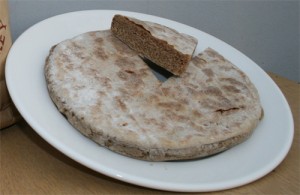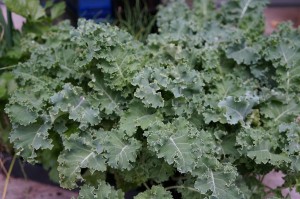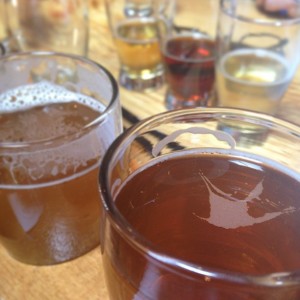The food of the tenant farmers, cottars and workers was simple and probably did not vary greatly during the year. The main diet was almost vegetarian consisting of oatmeal, knockit(1) and kail (or kale).
Oatmeal
It should be remembered that at the time Oats were the food given to horses in England and so was the source of ridicule for Englishmen (2) visiting Scotland. This was the largest crop in Speymouth and indeed most of Scotland
The oatmeal was prepared in a number of ways:
Porridge
Traditionally this was simply water, oatmeal and salt. The water was brought to the boil and the oats sprinkled on top and stirred in and brought back to the boil. The mixture was then gently simmered for an undefined time. After about 20 minutes the mixture would be ready but sometimes it was reduced to a bare heat and left overnight. The overnight method may have arisen because of the need not to work on the Sabbath. Clearly making sure that the mixture does not stick and burn on the bottom of the pan is vitally important. A measure of one part of the coarse oatmeal to 6 parts of water is thought of as a good ratio.
Sowans
Sowans or sowens (from Scottish Gaelic: sùghan meaning juice) is a dish made using the starch remaining on the inner husks of oats after milling, known as sids. The husks are soaked in water and ferment for between a few days and a week. The solids sink to the bottom and the liquor is strained off and allowed to stand further for a day to allow the remains of the starchy matter sink. The liquid part, known as the swats can be drunk. The remaining sowans are boiled with water and salt until thickened like porridge. They can be served with cream, butter or dipped into milk. The flavour is distinctly sour. It was traditional on St Brigit’s day (Feburary 1st which marks the Celtic beginning of Spring), and Christmas Eve or Christmas morning.
 Bannocks (Oat Cakes)
Bannocks (Oat Cakes)
Bannocks are made on a Gridle or Girdle in Scots. This is a flat iron suspended over a open fire on which a flat oat based bread can be prepared. The Oats were sometime mixed with Barley or Bere and made into a wet dough which was then cooked slowly on the Gridle.
When they were cut into smaller portions they were also known as scones.
 Kail or Kale
Kail or Kale
Kail, Brassica oleracea (acephala group) is a hardy cabbage plant that grows natively in Scotland and other northern climes. It flourishes well in organic soil or soil that is fertilised with organic fertiliser. It flourishes with a light frost and is at its best during the winter months from November to March. The kailyard was an integral part of the farms and holdings of even the lowly cottar in Speymouth from the 17th century.
This makes it an ideal source of nourishment when most needed. Kail provides rich nutritional ingredients that offer a very high Vitamin C content (120mg gives 200% RDA), Vitamin K (100g gives 700% RDA) and helps against such diseases as Alzheimers, protection from vitamin A deficiency (100g gives 512% RDA), osteoporosis, iron-deficiency anaemia, and is believed to protect from cardiovascular diseases and colon and prostate cancers. Currently it is known as a superfood!
The only problem with his vegetable was the way that it was prepared boiling out all of the fibre and other components. Boiling kail for just 5 minutes removes 33% of the Vitamin C and total carotenoids by 16%(3). Furthermore the soluble protein and sugars are as degraded. The means of preparation in other words of boiling overnight or even days meant that the natural nourishment was substantially diminished.
The lack of vitamin C has led to the conclusion and documented evidence of severe scurvy in some populations in Scotland by the end of the winter. (See Health and Illness)
Knockit
Knockit is roughly pearled Bere or Barley, This was made into broth or soup with the addition of fowl or bones and on rare occasions mutton. Other vegetables including Kail will have been added. Sometimes peas were added.
In certain areas of Scotland this word has passed to mean bread (4).
KNOCKIT, s. A piece of bread, eaten at noon as a luncheon, Dumfr.; Twall-hours synon. In Galloway Nacket. Most probably from the size of the piece of bread, Su.G. kneck globulus. V. Nocket.
KNOCKIT BARLEY or BEAR.] Add;
The pure men plentis that duellis besyde him.
How he creipis in a hoill to hyde him, —
When they come there to crave their debtis ;
For kaill, candle, and knocked beir,
Herbis to the pot, and all sic geir,
He never payis ane penny he takkis.
Legend Bp. Si. Androis, Poems 1 6ih Cent. p. 323, 324.
 Ale
Ale
Ale was brewed domestically as part of a woman’s work. It was nutritious and not very strong and was used as a substitute for milk when none was available – this included washing down porridge. There were no hops available and so the ale was sometimes bittered using heather, myrtle or broom. Not adding hops meant that it did not last as long as other beers. The result was that it was made in smaller batches and sometimes still served still warm(5). The extensive boiling meant that pathogens would have been killed in the process and would probably made it safer that drawing water form both the river or a well.
Salmon
In Speymouth there will have been a plentiful supply of Salmon with one of the best Salmon fishing areas right beside it. What the rights or perhaps simple takings were is unknown.
Apart from being eaten fresh it was probably preserved in salt and every part would have been eaten including the liver a very nourishing dish. The term kipper in Aberdeenshire often referred not only to herring but also Salmon. In some cases there was such abundance that people refused to eat it more than three times a week: The Scottish Gael (1831), James Logan writes, “In Aberdeenshire the servants, during the summer, had so much salmon that they refused to eat of it oftener than twice a week.”
Everyday Diet
A good account of the everyday diet come from Douglas’s Description of the East Coast of Scotland(6). Supper was taken at 7pm in the winter and 9pm in the summer.
At ten or twelve miles distance from a town (the town in question is Aberdeen), flesh is never seen in the houses of the common farmers, if it be not at a baptism or wedding, when they have it in great profusion, especially poultry ; or at Christmas, and Fasten-even, (Shrove Tuesday) two festivals, the observance of which presbytery has not been able to suppress. Their common food is oatmeal, milk, and vegetables, chiefly red- cabbage, in the winter season, and cole-worts for the the summer and spring. I shall give you a farmer’s bill of fare for a day, which is just equal to giving one for a twelvemonth, merry-making times, and the two festivals, only excepted.
BREAKFAST
POTTAGE, made of boiling-water, thickened with oatmeal, and eat with milk or ale. Or brose broth, made of shorn cabbage, or cole-worts, left over night. After either of which dishes they eat oat cakes and milk; and where they have not milk, kale, or small beer.
DINNER.
SOWENS, eat with milk. Second course, oat cakes, eat with milk, or kale. Sowens, are prepared in this manner. The meally sid, or hull of the ground oat, is steeped in blood-warm water, for about two days, when it is wrung out, and the liquor put through a search ; if it is too thick, they add a little fresh cold water to it, and then put it on the fire to boil, constantly stirring it, till it thickens, and continuing the boiling till it be comes tough like a paste. In the stirring they mix a little fait, and dish it up for table.
SUPPER.
FIRST course, during the winter season, ka!e-brose, eat about seven at night, while, at the fireside, the tale goes round, among the men and maid servants.
Second course, kale, eat with oat-cakes, about nine. During the summer season, there is generally but one course, pottage and milk, or oat-cakes, and kale, or milk. Kale is thus prepared, red-cabbage, or cole-worts, are cut down, and shorn small, then boiled with fait and water, thickened with a little oatmeal, and so served up to table. Brose, is oatmeal put into a bowl, or wooden dish, where the boiling liquor of the cabbage or cole-worts are stirred with it, till the meal is all wet. This is the principal dish upon the festival of Fasten-even, which is emphatically called Beef-brose-day.
IN harvest they sometimes have a thick broth made of barley and turnip (Turnips were not introduced into Scotland until the late 18th century), in place of sowens, and if near a seaport, frequently some kind of fish, which they eat with butter and mustard. I should have added to the number of their festivals, what they call the Clyak-feast(7), or, as it is called in the south and west,. the Kirn. This is celebrated a few days after the last of their corns are cut down, when it is an established rule that there must be meat, both roasted and boiled.
SHOULD this letter fall into the hands of an epicure, while he nauseates the poor viands of these people, and blesseth himself in his abundanc ; as a friend, I would whisper in his ear, that they are strong and active; sleep sound, and live to a good old age. Perhaps, once or twice in their lives, they may hear of a person afflicted with the gout, an asthma, or low spirits. I would tell him what would surprise him more, that these boors have a delicacy of sentiment in regard to eating, to which he only pretends. That their stomacbs would rife were they to see his soups and olios compounded, and that they would turn their dog out of doors had he dined upon a haunch of venison dress’d in the gout alamode.
- “Knockit beir n.”. Dictionary of the Scots Language. 2004. Scottish Language Dictionaries Ltd. <http://www.dsl.ac.uk/entry/dost/knockitbeir> ↩
- Graham, Henry Grey. The Social Life of Scotland: In the Eighteenth Century. Vol. 1. 1899. Reprint. London: Forgotten Books, 2013. 178-9. Print. ↩
- Yuan, Gao-feng et al. “Effects of Different Cooking Methods on Health-Promoting Compounds of Broccoli .” Journal of Zhejiang University. Science. B 10.8 (2009): 580–588. PMC. Web. 24 Apr. 2015. ↩
- Jamieson, John. A Etymological Dictionary of the Scottish Language…: Supplement. Printed at the University Press for W. & C. Tait, 1825. ↩
- Graham, Henry Grey. The Social Life of Scotland: In the Eighteenth Century. Vol. 1. 1899. Reprint. London: Forgotten Books, 2013. 179. Print. ↩
- Douglas, Francis. A General Description of the East Coast of Scotland from Edinburgh to Cullen… 1782. ↩
- The Clyak feast was the feast given to the workers on the last day of the harvest. “Clyack n.”. Dictionary of the Scots Language. 2004. Scottish Language Dictionaries Ltd. <http://www.dsl.ac.uk/entry/snd/clyack> ↩



